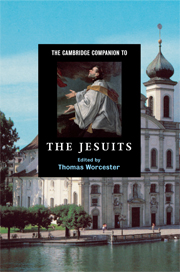Book contents
- Frontmatter
- Introduction
- Part I Ignatius of Loyola
- 1 The religious milieu of the young Ignatius
- 2 Five personae of Ignatius of Loyola
- 3 The Spiritual Exercises
- Part II European Foundations of the Jesuits
- Part III Geographic and Ethnic Frontiers
- Part IV Arts and Sciences
- Part V Jesuits in the Modern World
- Select bibliography
- Index
1 - The religious milieu of the young Ignatius
from Part I - Ignatius of Loyola
Published online by Cambridge University Press: 28 September 2008
- Frontmatter
- Introduction
- Part I Ignatius of Loyola
- 1 The religious milieu of the young Ignatius
- 2 Five personae of Ignatius of Loyola
- 3 The Spiritual Exercises
- Part II European Foundations of the Jesuits
- Part III Geographic and Ethnic Frontiers
- Part IV Arts and Sciences
- Part V Jesuits in the Modern World
- Select bibliography
- Index
Summary
The Spanish Christianity that Ignatius of Loyola experienced between his birth in 1491 and his departure from Spain in 1527 was often unexpectedly flexible, even when authorities of Church and State tried to make Christians conform to new religious standards. Despite the formal powers of kings, inquisitors, and bishops, it was one thing to pronounce a change, but quite another to carry it out; and modern historians are unanimous in emphasizing the degree to which local environments in Spain routinely outflanked or complicated centralizing mandates. Those local milieux also exhibited a range of religious commitments and achievements. The Spanish laity frequently was deeply involved in religious life, and men and women often demanded better clergy, better sermons, and the more frequent reception of the sacraments. At the same time, a substantial proportion of the laity voiced doubt about some theological truths, such as the Immaculate Conception of the Virgin Mary, and failed to know basic Catholic prayers. Competent clergy could be hard to find, but energetic ecclesiastics also could galvanize a diocese. This variation was enhanced by a printing boom that made religious texts in Spanish accessible to everyone with the ability to read or desire to listen, and yet persons could attend to the divine through revelations from God as well as written catechisms: in fact, heavenly messages propelled accountants and wives, as well as nuns, into roles as spiritual advisors, and such individuals counseled their followers for years without arousing substantial mistrust. Thus for the first three decades of his life, Ignatius saw variety in his religious world as well as standardization. As a result, there very often remained a space for individual religious initiatives, even if total religious freedom was unthinkable.
- Type
- Chapter
- Information
- The Cambridge Companion to the Jesuits , pp. 13 - 31Publisher: Cambridge University PressPrint publication year: 2008
- 2
- Cited by

